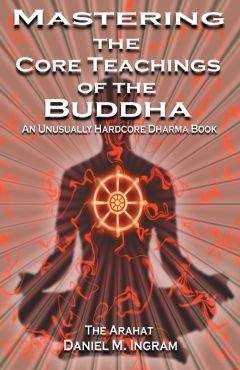Daniel Ingram - Mastering the Core Teachings of Buddha - An Unusually Hardcore Dharma Book
На электронном книжном портале my-library.info можно читать бесплатно книги онлайн без регистрации, в том числе Daniel Ingram - Mastering the Core Teachings of Buddha - An Unusually Hardcore Dharma Book. Жанр: Прочее издательство -, год 2004. В онлайн доступе вы получите полную версию книги с кратким содержанием для ознакомления, сможете читать аннотацию к книге (предисловие), увидеть рецензии тех, кто произведение уже прочитал и их экспертное мнение о прочитанном.
Кроме того, в библиотеке онлайн my-library.info вы найдете много новинок, которые заслуживают вашего внимания.

Daniel Ingram - Mastering the Core Teachings of Buddha - An Unusually Hardcore Dharma Book краткое содержание
Mastering the Core Teachings of Buddha - An Unusually Hardcore Dharma Book читать онлайн бесплатно
From Content to Insight
then I found myself thinking about the Big Issue again, thought after thought, mostly the same old thoughts repeating again and again.”
This person is already making progress towards using these thoughts and physical sensations as a basis for insights. They are beginning to try to apply the assumptions of insight practices to their experience. They are trying to focus on a physical object, trying to notice the individual sensations that make up their thoughts and physical sensations.
However, they have poor concentration and have not learned to see the true nature of the sensations that make these up.
“I sat down on the cushion, and I tried to see each of the sensations that make up the breath. Interspersed with these physical sensations were mental images of the breath. Interspersed with all of these sensations were also thoughts about the Big Issue. They were quick and seemed to also involve some mildly painful or disconcerting physical sensations in the region of my stomach. I could see these come and go and that they were observed. I could feel as they arose that there was something irritating about these quick sensations.
“I noticed that most of my experience was made of sensations that didn’t seem to relate to that Big Issue. Sometimes I noticed the three characteristics of the sensations that seem to be related to the old Big Issue pattern of sensations, and sometimes I was able to stay with the sensations of breathing. However, regardless of which sensations arose, I was generally able to see some aspect of the true nature of them. Thus, I find that I am able to keep practicing and not get lost in old, circular thoughts about that Big Issue that do me little good and have caused me much pain.”
These are the sorts of descriptions that really light up a meditation teacher’s eyes. They can see that this is a person who really is getting a sense of what is insight practice and how it can be useful. The meditator not only understands the focus and assumptions of insight practices but are also able to actually do fairly consistent and strong practice. Even being able to do this when we are walking around and dealing with our stuff can be helpful. Shifting to the sensate level reveals things about our stuff that can be very helpful for keeping it in perspective and not getting overwhelmed by it. It also develops habits that make it easier for us to shift to a sensate level when we do formal insight practice.
128
From Content to Insight
Thus, if you have an issue that keeps bugging you, try taking the time to see the Three Characteristics of the sensations that make it up as you go about your day, thinking, “The pattern of sensations that make up the Big Issue are quick, transient, and observed. I will do my best to notice this as those sensations occur. When speaking of the Big Issue to others and to myself, I will try to keep my descriptions at an insight-oriented level. By seeing this Big Issue as objective and transient phenomena, I will not be lost in my negative and painful thoughts about my Big Issue. I will be able to bring more clarity and spaciousness to the Big Issue, able to bring more intelligence to the Big Issue, able to bring more common sense and balance to the Big Issue. If I can do this, it will be of great benefit to me. If I continue to wallow in my circular thoughts about my Big Issue that get me nowhere, I will simply experience unnecessary pain to little good effect. This is my plan and my resolve. Though I may fail again and again to be able to do this, eventually I will break the habit of not being able to see the true nature of the Big Issue and thus will grow in wisdom and happiness!” That’s the way the game is played.
Just for fun, I will give two more examples from even more
advanced practitioners and how they might describe their practice. “I sat down on the cushion and began noticing the three characteristics of the sensations that make up experiential reality showing themselves. There were physical and mental sensations, all arising and vanishing quickly and effortlessly. I could see perhaps 5-15 sensations per second, primarily in the abdominal region, but there were many other little sensations coming in from all over, colors on the back of my eyelids, sounds from other meditators breathing. Occasionally, there were some quick sensations interspersed with these about that Big Issue, like little phantoms vanishing in a sea of flickering color and form. They caused no interruptions in my investigations, being just more sensations for investigation.”
This is obviously a strong practitioner with solid insight skills. They know exactly what they are looking for and do so. They are willing to make time for bare sensate investigation. We cannot instantly make the transition to this sort of practice, but I am a firm believer that making clear exactly what we are looking for can make it much easier to actually 129
From Content to Insight
make the transition from content to insight. By observing what we are able to do and taking a look at what someone at the next higher skill-level can do, we will be able to proceed with more confidence that we are on the right track.
This last example is a description of practice from a particularly strong and advanced practitioner. “I sat down on the cushion and the cycles of insight presented themselves effortlessly. There was a shift, and very fine, fast vibrations arose instantly, dropping down quickly, and then they shifted out, getting vague for a few seconds. Concentration restabilized and revealed the quick ending of sensations one after the other, perhaps 5-10 per second, and then things began thickening somewhat, getting somewhat irritating, but vibrations remained the predominant experience. It was just that their unsatisfactory aspect became more predominant, and there were a few sensations relating to the Big Issue.
“I may have noticed a few hints of what dualistic perspectives remain and the basic pain and confusion they cause. There was a shift, and a more panoramic and easy perspective arose, accompanied by more coherent and synchronized vibrations including most of sensate reality, including much of space, at perhaps 5-15 per second. There was a short period of barely noticeable but mature equanimity in the face of these as the vibrations became more inclusive. Any sense of practicing dropped away entirely.
“A minute later, two of the Three Characteristics presented
completely in quick succession, including the whole background of space, revealing something incomprehensible in the nature of subject and object, and reality vanished. Reality reappeared quiet, clear, beautiful and easy. I solidified space in that afterglow so as to enjoy the formless realms for a few minutes, rising up through them and back down to boundless space. A vision relating to the Big Issue arose.
“I stabilized on the vision, noticing the feeling of it, and before I knew it I was out of body, traveling in a strange realm, having interactions that replayed the issue of the Big Issue in symbolic or mythic form. I saw something about this issue that I never had before, how an old, unexamined and fictitious train of associations lead to my inability to come to some more balanced understanding of this issue.
130
From Content to Insight
This epiphany broke my concentration, and I returned to my body. I then dropped out of the formless realms, allowing a new insight cycle to begin again. When I got up off the cushion, I noticed that the psychological insights that arose in the other realm gave me an increased sense of humor and a more compassionate perspective towards those involved in this issue. They were just trying to be happy, just as we all are. It will be interesting to see how this plays out.”
They have talent and a wide range of skills. They are not only an advanced insight practitioner, but they also have strong concentration skills and can even chance into some of the more unusual concentration attainments. Further, they even seem to be able to use their ability to travel out of body to gain relative insights into the content of their stuff.
Last, they are on the look out for the subtle signs of the limits of their insights. They are not only skilled, but they realize what they do not yet know. They are well on their way to mastering the core teachings of the Buddha.
131
PART III: MASTERY
132
20.CONCENTRATION VS. INSIGHT
There is a lot of confusion on the differences between concentration practices and insight practices. This may be caused in part by the
“Mushroom Factor,” or may be due in part to other factors, such as concentration practice being easier than insight practices and distinctly more pleasant most of the time. Concentration practices (samatha or samadhi practices) are meditation on a concept, an aggregate of many transient sensations, whereas insight practice is meditation on the many transient sensations just as they are. When doing concentration practices, one purposefully tries to fix or freeze the mind in a specific state, called an “absorption,” “jhana” or “dyana.” While reality cannot be frozen in this way, the illusion of solidity and stability certainly can be cultivated, and this is concentration practice.
Insight practices are designed to penetrate the Three Illusions of permane nce , sati sfactorines s and separate self so as to attain freedom. (N.B., the illusion of satisfactoriness has to do with the false sense that continuing to mentally create the illusion of a separate, permanent self will be satisfactory or helpful, and is not referring to some oppressive and fun-denying angst trip). Insight practices (various types of vipassana, dzogchen, zazen, etc.) lead to the progressive stages of the progress of insight. Insight practices tend to be difficult and somewhat disconcerting, as they are designed to deconstruct our deluded and much cherished views of the world and ourselves, though they can sometimes be outrageously blissful for frustratingly short periods.
Concentration states are basically always some permutation of great fun, extremely fascinating, seductive, spacious, blissful, peaceful, spectacular, etc. There is basically no limit to how interesting concentration practices can be. Insight practice stages and revelations can also be very interesting, but are not potentially addictive the way concentration states and side effects can be. Insight practices tend to be hard work most of the time even if that work is just surrendering to things as they are.
One of the factors that actually adds to the confusion is that the concentration state terminology (jhanas) is used in the original texts to describe both the progressively more sophisticated concentration states
Concentration vs. Insight
and also the progress of insight, with little delineation of which was which. This was solved to some degree a few hundred years later when the stages of the progress of insight were articulated in the canonical commentaries, but the original problem was not mentioned. It was only in the second half of the 20th Century that the problem was sorted out to some degree by the Burmese, and I will delineate the vipassana jhanas later.
To try to keep this clear in a way that the old texts simply don’t, whenever I refer to jhana without mentioning whether I mean samatha or vipassana jhana, I always mean samatha jhana, a stable state produced by concentration practices. When I refer to those jhanas produced by insight practices, I will always call them vipassana jhanas.
Concentration practices develop concentration but they don’t develop wisdom. The problem is that concentration states can easily fool people into thinking that they are the end goal of the spiritual path because these states can become so blissful, spacious, and even formless, and thus can closely match some imprecise descriptions or expectations of what awakening might be like.
However, concentration practices can be very helpful and are very important. Without at least some skill in concentration practices, insight meditation is virtually impossible. There is an esoteric debate in the ancient commentaries about some students who got enlightened without even attaining the lowest of the concentration states (the first jhana, explained later), practitioners called “dry insight workers,” but I wouldn’t bank on this being a common occurrence. Luckily, insight practices themselves can simultaneously develop concentration and insight, though the dangers of being seduced by concentration states can lie in wait there as well. In short, you must master the first jhana as a minimum basis for beginning the progress of insight, but this is all that is required for enlightenment.
So long as one is very clear about what is concentration practice and what is insight practice, which may not be as easy an understanding to come by as some might think, concentration practice beyond the first jhana can be helpful to the insight practitioner. All of the concentration states stabilize the mind, obviously, and this has four primary benefits.
First, just a movie camera that is shaking wildly will not be likely to 134
Concentration vs. Insight
produce a clear or intelligible movie, so a mind that won’t stay settled on an object will not clearly perceive the ultimate truth of it. Second, as concentration states cultivate deep clarity and stability on content, they are very useful for promoting deep and healing psychological insights.
Put another way, if you want to bring up your stuff, do concentration practices.
Third, concentration states can be a welcome and valid vacation from stress, providing periods of very deep relaxation and peace that can be an extremely important part of a sane, compassionate and healthy lifestyle. The Buddha highly praised those who had mastery of the concentration states, and this should serve as a reminder to those who underestimate their great value or erroneously feel that not enjoying one’s life is somehow “spiritual.” Fourth, concentration practices can help the insight practitioner stay somewhat more mentally stable and balanced as their old concepts of their existence are rent asunder by insight practice. However, if these states end up blocking this process by solidifying a sense of self as being anything or creating aversion to clearly experiencing suffering then they become a hindrance.
This is a very tricky balance. If a student clings to stability or fluidity they will surely not make progress in insight. However, if they plunge into the fast and harsh vibratory experiences of insight practice without the soothing effects of concentration practice to help them stay somewhat grounded, the student can be a bit like someone who has taken a small dose (or a big dose in the worst cases) of LSD or drunk way too much coffee. I spent the first five years of my practice giving only a moderate amount of attention to the samatha jhanas and I now realize that this was probably an error.
Sometimes spiritual openings can be extreme and dramatic, and being able to slow things down and calm down can sometimes be very useful and skillful if we have to deal with the world and deal with these openings at the same time. In short, if you want to gunk up your insight practice because you simply need to slow down so as to be able to get on with your life or not completely flip out, such as to study for medical school boards, etc., one way to do this is to indulge in concentration states. Coupling this with formal resolutions to not make progress in insight can be very effective.
Похожие книги на "Mastering the Core Teachings of Buddha - An Unusually Hardcore Dharma Book", Daniel Ingram
Daniel Ingram читать все книги автора по порядку
Daniel Ingram - все книги автора в одном месте читать по порядку полные версии на сайте онлайн библиотеки My-Library.Info.




